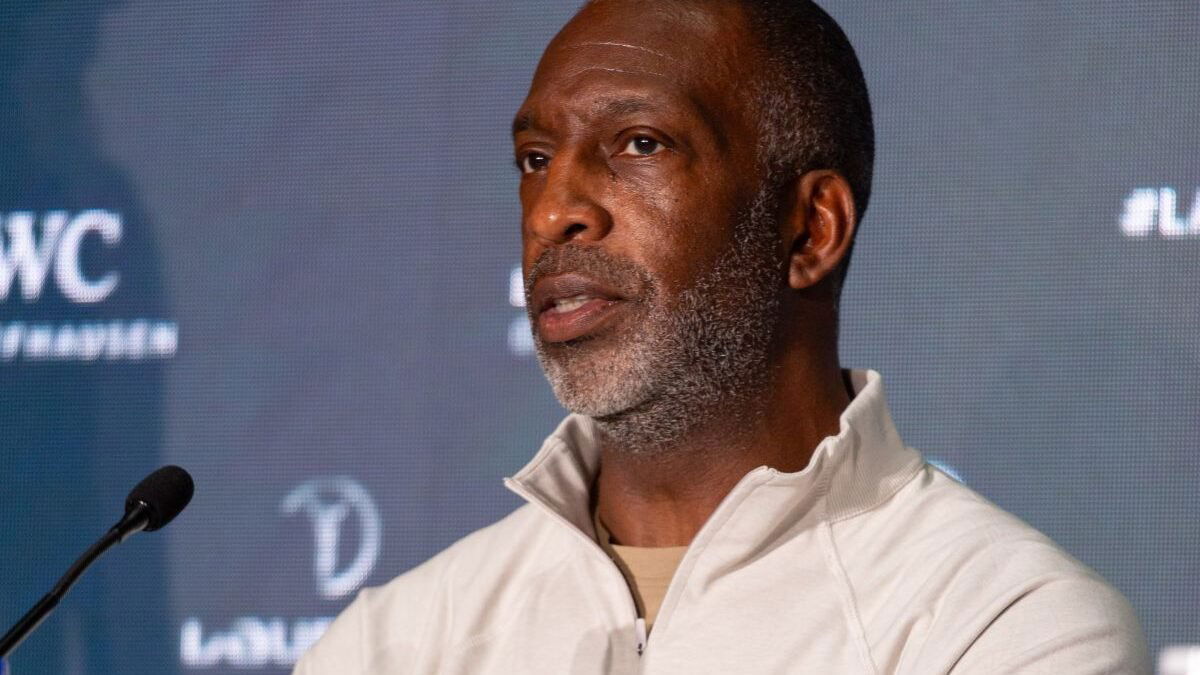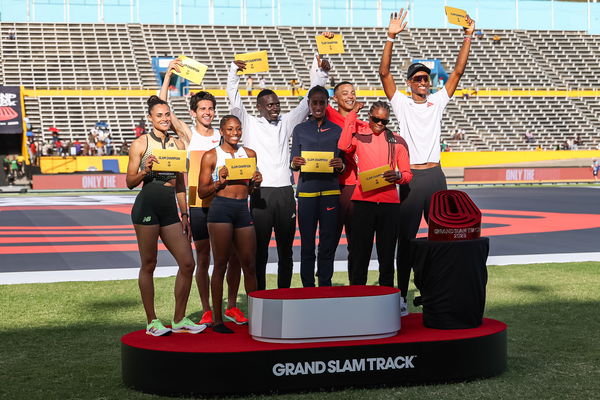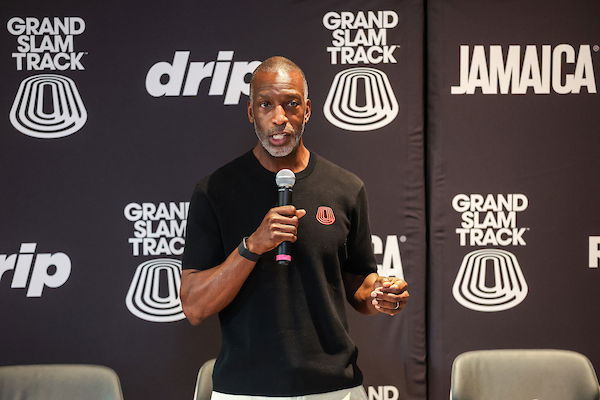

There’s no money in track, or so they say… Funny how athletes keep saying track and field is broke, yet when someone finally puts real money on the table, they vanish like a false start. Remember when Noah Lyles said the sport was dying? He wasn’t just ranting—he was pointing out the truth. But now Michael Johnson’s out here trying to revive it, offering a big cash prize. And yet… crickets. Some athletes still choose low-paying overseas meets and then turn around and say there’s no money in the sport. So is the track broken, or are some just passing on the paycheck? Let’s get into it.
Watch What’s Trending Now!
Michael Johnson’s Grand Slam Track league isn’t just another competition—it’s a game-changer for track and field. Launched in April 2025, it’s shaking up the sport by offering serious prize money and a fresh take on how meets should be run. We’re talking four events a year, each with a prize pool of $12.6 million. Winners walk away with $100K, and even the eighth-place finishers pocket $10K.
Yep, you could make up to $400K in just four meets. Compare that to the Paris Olympics, where a gold medal gets you $50K, or the Wanda Diamond League’s $10K prize for winning a regular event. So why are some athletes still hesitant to jump on this? Erin Brown, who has been vocal about it, shared his thoughts on X. “Welcome to track, where athletes complain about not getting paid enough but will turn down the opportunity to make $400K in 4 meets for $10K in prize money and an appearance fee lol.”
ADVERTISEMENT
Welcome to track where athletes complain about not getting paid enough but will turn down the opportunity to make $400k in 4 meets for $10k prize money and an appearance fee lol
— The Erin Brown🕷 (@TheErinBrown) April 30, 2025
It’s a solid point. If the money’s on the table, why not take it? Johnson is offering one of the richest payouts in the sport, and it’s open to everyone, not just the big stars. Every finalist, even the eighth-place finisher, gets paid. It’s the richest per-meet payout in track right now. But that doesn’t mean it is safe from runners pulling out of it. And the fans don’t seem to be too happy with their reactions.
ADVERTISEMENT
Fans heat up on whether Michael Johnson’s league is the future of track and field
While on paper everything looks good for GST, the same can’t be said about what’s happening in reality. As one user chimed in with, “Those appearance fees aren’t small though… but I get you,” and Erin didn’t let that slide. He clapped back, “They aren’t 100K, especially for an MF competing in a non-premier event,” then added, “It’s the richest ones complaining.”
And here’s the kicker—despite all that money floating around in Michael Johnson’s league, a chunk of athletes are still shrugging it off. The checks are there; the opportunities are real, but somehow, people keep walking past them. No surprise the track and field world is buzzing—opinions are flying left and right. One fan hit the nail on the head: “Ong, I just found out there’s a little bit of money on track; idk how people are complaining.”
ADVERTISEMENT
And honestly, they’ve got a point. With prize money finally being put front and center, thanks to things like Grand Slam Track, calling it a “dying sport” doesn’t hold the same weight anymore. The cash is there. The opportunity is there. But oddly enough, some athletes still seem to look the other way. Olympic champion Noah Lyles, for example, said he’s interested in joining GST but stressed the importance of securing a TV deal to make it worth his time—visibility still matters.
Top Stories
Fact Check: Were Greg Biffle & Family On the Plane That Crashed At Statesville, North Carolina?

“Rest in Peace”: Prayers Pour In From Dan Marino as Dolphins Legend Mourns Tragedy in South Florida Football

Carlos Alcaraz’s Split With Coach Resulted From ‘Major Disagreements’ With His Father

Who Is Greg Biffle’s Wife? Everything You Need to Know About Cristina Grossu

Footage Surfaces of Florida Police Arresting NASCAR Veteran Over Disturbing Public Misbehavior

Tony Pauline’s 2-Round 2026 Mock Draft: Browns Secure Franchise QB, Commanders Beat Chiefs to Jeremiyah Love


ADVERTISEMENT
Meanwhile, one other user pointed out, “N****s turned down Grand Slam to go run in Florida for free.” And honestly, it hits harder when you remember how rough the first GST meet in Kingston was—low attendance, last-minute athlete withdrawals, and scheduling headaches all around. Despite Michael Johnson putting his legacy on the line to uplift the sport, top stars were nowhere to be found. When track and field needed its own to show up, the stands were half-empty and attention was elsewhere—on Pepsi Florida races or the Diamond League.
One fan didn’t mince words: “Those athletes are the problem. And I feel those at the top don’t like the idea of GST because of who is running it and the fact that everybody gets paid, no favoritism.” Another chimed in, “You have to win 10 Diamond League races to make 100K and then wait for your money. Vs. GST—you get paid to join, make more in fewer races, and they hand you the check. Lol.” It’s a sentiment that’s been echoing through the track and field community—GST isn’t just changing the pay scale; it’s changing the power dynamic, too.
ADVERTISEMENT
To rake in $100,000 in the Diamond League, an athlete usually has to win 10 standard events (worth $10K each) or five Diamond+ events, which pay $20K a win. And even then, the prize money often comes with delays due to federation red tape and payout cycles. Add to that the grueling travel, inconsistent scheduling, and unpredictable lane draws, and it’s a grind. In contrast, GST pays you just for showing up.
One fan laid it all out: “DL gives away almost $10 million in appearance fees over the season. Some athletes get close to $100K for one race. Plus prize money. Plus, big crowds. Plus, less travel. Plus iconic stadiums. Plus, Europe is just nicer.” And sure, on paper, that’s a sweet deal. For the 2025 season, the Diamond League is dropping a total of $18 million on athlete compensation, including both prize money and those juicy appearance checks.
ADVERTISEMENT

But not every number is public. Some top-tier names, especially Olympic or World champs, can command $30K to $50K per meet and occasionally even hit that $100K mark if they’re a major headliner. Add in the chance to race in legendary venues in front of packed European crowds? It’s hard to complain. But when stacked against the GST, it’s a matter of fame vs. money.
ADVERTISEMENT
After all, there’s no waiting on federations to process payments. No guesswork on appearance fees. Just straight-up, guaranteed money. While the Diamond League offers prestige and tradition, GST offers immediacy, equity, and fewer competitions for bigger returns. So the real question is: what’s more valuable—legacy or leverage? Will Michael Johnson usher in a new age? Or is this all for nought?
ADVERTISEMENT
ADVERTISEMENT
ADVERTISEMENT

